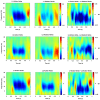The Role of the Motor System in L1 and L2 Action Verb Processing for Chinese Learners of English: Evidence from Mu Rhythm Desynchronization
- PMID: 38667064
- PMCID: PMC11047514
- DOI: 10.3390/bs14040268
The Role of the Motor System in L1 and L2 Action Verb Processing for Chinese Learners of English: Evidence from Mu Rhythm Desynchronization
Abstract
The nature of semantic representation has long been a key question in linguistic research. The Embodied Cognition theory challenges the traditional view of language representation, stating that semantic information stems from the sensory-motor cortex, which is activated automatically during semantic processing. However, most of the evidence comes from monolingual studies; it remains unclear whether second-language (L2) comprehension involves different semantic representations or mirrors the pattern seen in first-language (L1) processing. Therefore, the present study investigated the role of the sensory-motor system in language processing via making Electroencephalography (EEG) recordings during the processing of L1 and L2 action verbs. The results showed that L1 (Chinese) action verbs generated higher mu-event-related desynchronization (ERD) than L1 abstract verbs in the early processing stage (250 ms after verb presentation), and the same phenomenon was also observed for L2 (English). The results also indicated that language modulated the processing of action verbs, with L1 action verbs eliciting stronger ERD than L2 action verbs. These results demonstrate that the sensory-motor cortex plays a crucial role in comprehending both L1 and L2 action verbs.
Keywords: Mu rhythm; embodied cognition; event-related desynchronization (ERD); motor system; second-language processing.
Conflict of interest statement
The authors declare no conflicts of interest.
Figures

Similar articles
-
Cortical motor systems are involved in second-language comprehension: evidence from rapid mu-rhythm desynchronisation.Neuroimage. 2014 Nov 15;102 Pt 2:695-703. doi: 10.1016/j.neuroimage.2014.08.039. Epub 2014 Aug 28. Neuroimage. 2014. PMID: 25175538
-
First Language Matters: Event-Related Potentials Show Crosslinguistic Influence on the Processing of Placement Verb Semantics.Front Psychol. 2022 Jul 7;13:815801. doi: 10.3389/fpsyg.2022.815801. eCollection 2022. Front Psychol. 2022. PMID: 35874339 Free PMC article.
-
Embodied Semantics: Early Simultaneous Motor Grounding in First and Second Languages.Brain Sci. 2024 Oct 25;14(11):1056. doi: 10.3390/brainsci14111056. Brain Sci. 2024. PMID: 39595819 Free PMC article.
-
Effects of TMS on different stages of motor and non-motor verb processing in the primary motor cortex.PLoS One. 2009;4(2):e4508. doi: 10.1371/journal.pone.0004508. Epub 2009 Feb 25. PLoS One. 2009. PMID: 19240793 Free PMC article.
-
Is Embodied Cognition Bilingual? Current Evidence and Perspectives of the Embodied Cognition Approach to Bilingual Language Processing.Front Psychol. 2019 Feb 6;10:108. doi: 10.3389/fpsyg.2019.00108. eCollection 2019. Front Psychol. 2019. PMID: 30787892 Free PMC article. Review.
References
-
- Fodor J.A. The Modularity of Mind: An Essay on Faculty Psychology. MIT Press; Cambridge, MA, USA: 1983.
-
- Fodor J.A. The Mind Doesn’t Work That Way. MIT Press; Cambridge, MA, USA: 2000.
LinkOut - more resources
Full Text Sources
Research Materials

